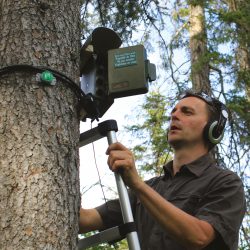Listening to Landscapes with the ecoacoustician Jérôme Sueur
Mankind imposes itself in the symphony of the world. Its solo never seems to end, silencing nature. Jérôme Sueur, an ecoacoustician and lecturer-researcher at the Muséum national d’Histoire naturelle in Paris, wishes for human beings to tone down. This interview by Anastasia de Villepin is published in issue AA 457 – Living Worlds.
 How would you define your area of expertise?
How would you define your area of expertise?
Ecoacoustics is a relatively recent scientific discipline. It emerged approximately ten years ago, combining issues of scientific ecology, that is, the monitoring of biodiversity and natural environments, with acoustics and sound. We deal with ecological issues and conservation biology through sound, by listening to natural environments.
This gives us information about the state of these landscapes and any changes they may undergo. For example, we are currently studying changes in the soundscape of the Risoux forest, a 3,300-hectare forest in the Jura mountains, by recording it regularly. We would like to extend this recording over ten, fifteen, maybe twenty years, so that we can then study the sounds at different ecological scales, to find out how the soundscape of this forest changes as a result of climate change. For example, by listening to the sounds of the capercaillie [a gallinaceous species found in coniferous forests, Ed.], an animal that has been hunted for many years, we can determine the state of the population, because it is very difficult to observe them without disturbing them. We are aiming to count the number of individuals just by listening. We have already worked on other sounds that represent “ecological functions” in the forest, such as the insects that pollinate flowers. As they flap their wings, they produce a buzzing sound that can be detected, revealing the pollination function of flowering plants. Combining this data with the sounds of insects and birds informs us about the state of the forest and how it is changing.
The term was coined at a conference held at the Muséum in 2014, but the practices predated that. This research was linked to a technical development: technique outpaced the research questions in 2008. For my part, I wasn’t recording insects, frogs or birds, but soundscapes, microphone in hand.
Then an American company developed automatic recorders that allowed us to record without having to “cool our heels” in the wild. Initially used to track birds, this recorder was later used to capture all the sounds in a given environment.
Is that what a soundscape is?
Yes, the term comes from “landscape.” It’s a beautiful, condensed term, and you immediately understand what it refers to: the sound version of a visual landscape. It’s all the sounds that can be found in a given place at a given time. The concept is not new; it dates back to the 1980s, when people began to study sound in a very “anthropised” way, in other words, starting with the sounds of the city.
Does this mean that there was indeed an interest in the study of sound on behalf of scientists, aside from these technical advances?
Not so much from scientists as from artists. As far as natural soundscapes are concerned, the idea came from the research of an American musician, Bernie Krause, who began recording the forests near his studio and then devoted his life to recording natural soundscapes. Whereas we were content to record outdoor sounds species by species, his approach was more global, more holistic. It was an artistic approach, linked to musical composition, but also to scientific ecology.
What are we talking about when we talk about sound? For that matter, when do we talk about sound, noise, singing or shouting?
The “noise, sound, silence” triptych is important. Sound is a mechanical phenomenon involving the vibration of air, water or a solid. These sounds transmit information. Noise, in a communication system, is also a sound, but one that is disruptive. For example, if someone else is talking at the same time as us, even if their speech is intelligible and interesting, it disturbs us and becomes noise. Noise has a negative impact on a system, and particularly on living beings: it can prevent us from concentrating or sleeping. It’s all relative, you can be the sound of one person and the noise of another.
Is it only living beings that produce sound?
As soon as there is movement, potentially, there can be sound. A flowing river, the wind hitting an obstacle, the imperceptible activity of the soil. This is what we call geophony. This classification, which also includes biophony (the natural sounds of non-human living beings) and anthropophony (human sounds), was drawn up by Bernie Krause. The distinction between these two fields is open to criticism: aren’t humans part of the living world? But separating human and non-human sounds is useful for describing our soundscapes and understanding their spatial and temporal dynamics. In a forest, there is a value to identifying whether 5% or 40% of the sound is anthropophonic. From an acoustic point of view, human beings are dominant. If we want to reposition humans in natural systems, there is a very significant imbalance in terms of sound: we move around a lot, we impose ourselves, to say nothing of our innumerable machines.
Are there some human sounds that might be more “valid” than others? Cases in which human sounds are beneficial to other living beings?
I don’t know of any. As soon as we arrive in a natural environment, we disrupt it, particularly with our machines. This might be called “technophony”: the noise of our transport, planes, cars, trains, building sites, mining operations. The idea is not to remain completely silent, but to be more discreet in our daily lives.
Incidentally, your latest book is entitled Histoire naturelle du silence (“A Natural History of Silence”, Actes Sud, 2023). Does silence exist?
Silence as the total absence of sound does not exist and, above all, it is not desirable. It would mean that there was no life. What I’m looking for is what I describe as natural silence, a silence that goes without saying, where human beings stand back and listen, with humility.
Ultimately, this silence would be a human silence.
It sounds very misanthropic, but yes, that’s about right! We’re not going to shut up and stop living; but we could be more restrained, move around less. Leaving sound space for others also means calming down.
People talk about green and blue belts (a network preserved for the development of animal and plant species) and black belts (particularly dark ecological corridors). Is there an equivalent for acoustics?
Yes, there is talk of a white belt. But I don’t really believe in it. Sound is difficult to control and you have to fight it at source. Wouldn’t it be better to use time frames instead? In some shops, there are time slots for people with autistic spectrum disorders, with less light and no music. The Amsterdam- Schiphol airport in the Netherlands plans to abolish night flights by 2026. Preserving quiet windows of time would already be a huge improvement. The first step is to raise awareness and listen to others. Sometimes, unfortunately, it is necessary to control things. In the Vallée de Chevreuse, to the south of Paris, certain tourist routes are much used by motorcyclists. Elected representatives and local residents are testing the installation of sound radars designed to measure the excessive noise made by motorised two-wheel vehicles.



